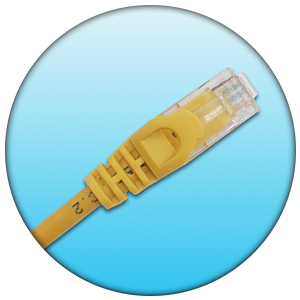Cable & Wire | Good quality and good service based on reasonable prices.
Cat 6 (Category 6) is a cable standard used mainly for Ethernet computer networking, security systems, and telephone services. Cat 6 cable is backward compatible with the Cat 5E, Category 6 cable is capable of transmitting voice and data up to 155 Mbps (mega bits per second), with possible transmission frequencies up to 550 MHz.

Cat 6 carries Ethernet 10Base-T, 100Base-TX, and 1000Base-T (Gigabit Ethernet) connections. Cat 6 cable is backed with more stringent specifications for crosstalk and system noise than earlier cabling standards.<o:p>
Category 6 cables come with four twisted copper wire pairs and each twisted pair is built of larger 23 gauge copper. The earlier model, Category 5, used 24 gauge copper wires. In wire gauges, a larger number indicates a smaller wire.
Cat 6 cables are generally terminated with RJ-45 electrical connectors. The signal path’s performance will be limited to that of the lowest category if components of the various cable standards are intermixed. The maximum length of one Cat 6 cable segment is 220 meters. A repeater needs to be installed to send data over longer distances or data loss may occur.
Solid and stranded Ethernet cables refer to the actual copper conductor in pairs. Solid cable uses a single piece of copper for the electrical conductor, while stranded uses a series of copper cables twisted together. There are many different applications for each type of conductor, but there are two main applications for each class you should know about.
l Stranded conductor: This type of wire is more flexible, and it is more applicable for Ethernet cables where the cable may be moved - often, it is an idea for patch leads at desks or general connections to PCs, etc., where some movement may be needed and expected.
l Solid conductor: Solid cable is not as flexible as the stranded type but is also more durable. This makes it best for use in permanent installations like cable installations under floors, embedded walls, and the like.
| Example materials used as insulation in the cable | |
| Acronym | Material |
| PE | Polyethylene |
| FP | Foamed polyethylene |
| FEP | Fluorinated ethylene propylene |
| FFEP | Foamed fluorinated ethylene propylene |
| AD/PE | Air dielectric/polyethylene |
| LSZH or LS0H | Low smoke, zero halogen |
| LSFZH or LSF0H | Low smoke and fume, zero halogen |
RJ-45 / CAT 5 / CAT 5E PINOUT & WIRING | ||||||
| PIN NO | TELEPHONE | 10BASE-T | 100BASE-T | 1000BASE-T | POE MODE A | POE MODE B |
| 1 | +TX | +TD | +BI_DA | 48 V out | ||
| 2 | -TX | -TX | -BI_DA | 48 V out | ||
| 3 | +RX | +RX | +BI_DB | 48 V return | ||
| 4 | Ring | +BI_DC | 48 V out | |||
| 5 | Tip | -BI_DC | 48 V out | |||
| 6 | -RX | -RX | -BI_DB | 48 V return | ||
| 7 | +BI_DD | 48 V return | ||||
| 8 | -BI_DD | 48 V return | ||||
ETHERNET CABLE MAXIMUM LENGTHS | ||
| SPECIFICATION | CABLE TYPE | MAXIMUM LENGTH |
| 10BaseT | Unshielded Twisted Pair | 100 metres |
| 10Base2 | Thin coaxial cable | 180 metres |
| 10Base5 | Thick coaxial cable | 500 metres |
| 10BaseF | Fibre optic cable | 2000 metres |
| 100BaseT | Unshielded twisted pair | 100 metres |
| 100BaseTX | Unshielded twisted pair | 220 metres |